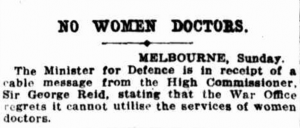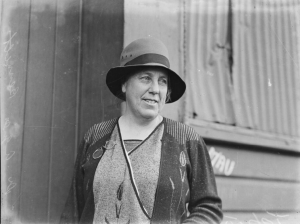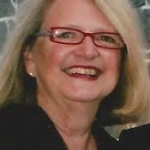Our series on inspirational women continues with Heather Sheard’s examination of Australia’s women doctors in World War I.
As the Great War rolled into 1915, Australian women doctors became exasperated with the refusal of military authorities to accept their attempts to enlist. So persistent were the attempts of women doctors throughout the British Empire to join their male colleagues on the battlefield that the Minister of Defence issued a notice in Australian newspapers stating that the ‘War Office regrets it cannot utilise the services of women doctors’.
 But women in medicine were accustomed to overcoming institutional barriers. Through their own networks, they used voluntary organisations to provide their professional skills to the war effort and to saving soldiers’ lives. More than twenty Australian women served as surgeons, pathologists, anaesthetists and medical officers in England, Egypt, France, Belgium, Serbia, Montenegro, Russia and Malta.
But women in medicine were accustomed to overcoming institutional barriers. Through their own networks, they used voluntary organisations to provide their professional skills to the war effort and to saving soldiers’ lives. More than twenty Australian women served as surgeons, pathologists, anaesthetists and medical officers in England, Egypt, France, Belgium, Serbia, Montenegro, Russia and Malta.
Why did they want to go? For each individual the combination of motivational factors no doubt differed and altered over time. There was the desire to honour their education and upbringing by loyally doing their duty for the British Empire. Some wanted the same personal agency their male colleagues took for granted. For others, part of the motivation may have been belief in their professional ability and an unconscious desire to demonstrate or test it. For some the war provided unique opportunities for professional development.
There were also motivations unrelated to women’s professional expertise. Like many soldiers who excitedly departed for foreign shores, some female doctors wanted to experience the adventure of travel and unknown places and challenges, leaving the humdrum of daily life and familial expectations behind. Others wanted to be near their fiancés, brothers and friends, or in proximity to where they had died.
And perhaps as the war raged on and on there was the desire to be part of such a momentous, life-changing event – just to be part of it.
A pivotal motivation for British women doctors was to prove themselves worthy of being granted the vote by serving on the battlefield. This led them to create voluntary military hospitals such as the Scottish Women’s Hospitals (SWH) and the Women’s Hospital Corps. These and other organisations like the Wounded Allied Relief Committee (WARC) gave Australian women the opportunity to join up.
Isobel Ormiston
Dr Isobel Ormiston from Albury arrived at a temporary hospital for refugees set up by the WARC in a casino hotel, Le Kursaal, on the Belgium coast at Ostend.
It was barely eight weeks since the German invasion of Belgium in early August 1914 and the hospital was rapidly inundated with wounded soldiers.
When the German army marched into Ostend on 15 October 1914, the operating theatre was in full swing and Isobel refused to leave her post. A prisoner-of-war for several weeks, Isobel was repatriated to England in mid-November.
By early May 1915, she was headed for Montenegro. The WARC had asked her to report on a serious typhus epidemic and she threw herself into the work in the Montenegrin town of Podgorica for the following seven months. When new staff sent by the WARC arrived, Isabel took charge of a military hospital with fifty wounded, a small isolation ward with six typhus cases and a huge out-patients department. When she had time she also worked with a local Turkish doctor who was attempting to care for the entire civilian population of the town.
Not wishing to again become a prisoner, Isobel departed Podgorica when the Austrian army invaded the country, undertaking a seven-day journey of almost seven hundred kilometres. Back in Australia, newspapers reported on the dangerous route to Salonika took her through the Dinaric Alps, reaching over eight thousand feet at times and meant riding mules and ponies along slender rocky tracks as well as travelling in a buggy and by train. Isobel served for the rest of the war at the WARC’s Hôpital Militaire Anglais set up in the Limoges porcelain factory in France.
Agnes Bennett

Dr Agnes Bennett was a highly qualified and experienced doctor whose offer to enlist was declined in both Australia and New Zealand (where she had established her medical practice). The French Red Cross were keen to accept her though and she left Wellington in April 1915 bound for Paris.
For almost a year, Agnes got no further than Cairo. As her ship arrived at Port Said, Australian and New Zealand soldiers were being unloaded onto the Port’s docks from the hospital ship the Guilford Castle and their stretchers laid out in the intense heat of early summer. Horrified, she realised they were AIF wounded from the Gallipoli battlefields.
Agnes left the boat to offer her services as a surgeon and was gladly accepted by Colonel Matthew Holmes, New Zealand’s Director of Medical Services who was working on the dock. Doctors, drugs and equipment were all in short supply in the early months of the disastrous campaign in the Dardenelles as wounded and sick soldiers poured into Cairo’s hospitals.
Agnes began the next morning on 19 May 1915 at the No. 2 New Zealand Stationary Hospital at Pont de Koubbeh in Abassia, Cairo with the recommended rank of Captain. In mid-1916, she departed for England and was readily recruited by the creator of the SWH, Dr Elsie Inglis. Dr Inglis was in need of a commanding officer for a new mobile unit being sent to Salonika to serve with the 3rd Serbian Army, which was in desperate need of medical provision.
For more than a year, until forced to step down by a severe bout of malaria, Agnes led a tented field hospital (their first job being to set it up) near Lake Ostrovo, eighty-five miles north-west of Salonika. She wrote of the lows:
We took about 24 cases, all terribly bad wounds, abdominal, chest, head, and compound fractures. It was terrible to see the poor fellows up at the dressing station. Five died before or just on arrival at the hospital. It was really a terrible day
Life in the Balkans is full of incident. On top of all our other troubles we had to contend with no end of pests, one of the worst of which were the wild dogs, like wolves, that used to keep up a monotonous baying all night and stealing our food unless we hung it out of their reach. Field mice used to eat our kit bags and our clothes: there were wasps in thousands: there were earwigs in millions
Yet there were also good times. When there was spare time the doctors rode horses, and the staff explored the beautiful countryside and villages on foot. Christmas was special with a hilarious dress-up parties and festive lunches. There were regular music concerts and visits from neighbouring soldiers’ camps and Serbian royalty. And the women learnt to dance the traditional Serbian ‘kola’. Victorian Dr Mary de Garis took over command when a very ill Dr Bennett had to depart late in 1917. However on recovering she served again on troopships and in hospitals in Glasgow and Southhampton when the Spanish Flu epidemic hit.
Legacies of Australian women doctors
When the women returned from their wartime service, they found that the gendered expectations of their role in medicine had changed little over the previous five years. Despite their intense experience of war surgery and illnesses, access to the newly developing areas of medical specialisation was exceptionally difficult for women doctors in the post-war years. Additionally, their lack of official enlistment meant that they could not take advantage of the policy of preference for those who had served with the forces. However, for some women their experience of female autonomy, leadership and professional skill in the demanding environments of war had provided a fresh level of confidence and encouraged them to develop new areas of public medicine. I find their stories inspiring because they put their professional skills to the test and often ignored their personal safety and skills, when neither was encouraged. They made and re-made themselves, seemingly without bitterness, and certainly with little recognition.
 Heather Sheard was a secondary school teacher and an assistant principal before retiring and completing a master’s thesis on the history of Victoria’s maternal and child health centres, published in 2007 as All the Little Children: The story of Victoria’s Baby Health Centres, and re-published in 2017. Her PhD thesis, completed in 2013 was a biography of Dr Vera Scantlebury Brown published in 2016 as A Heart Undivided: the biography of Dr Vera Scantlebury Brown. She is currently researching the contribution of Australian women surgeons during World War One.
Heather Sheard was a secondary school teacher and an assistant principal before retiring and completing a master’s thesis on the history of Victoria’s maternal and child health centres, published in 2007 as All the Little Children: The story of Victoria’s Baby Health Centres, and re-published in 2017. Her PhD thesis, completed in 2013 was a biography of Dr Vera Scantlebury Brown published in 2016 as A Heart Undivided: the biography of Dr Vera Scantlebury Brown. She is currently researching the contribution of Australian women surgeons during World War One.
Copyright remains with individual authors who grant VIDA holding a perpetual, world-wide, royalty free and non-exclusive license to use, distribute, reproduce and promote content. For permission to re-publish any VIDA blog post, in whole or in part, please contact the managing editors at auswhn@gmail.com.au
